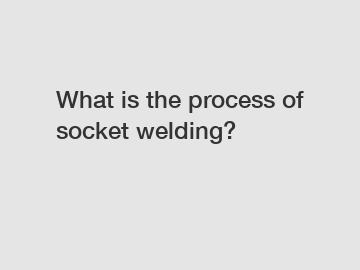What is the process of socket welding?
Socket welding is a technique widely used in various industries to create strong and leak-free joints in pipes and fittings. This welding method offers a reliable and durable connection that is well-suited for high-pressure applications. In this blog, we will delve into the intricacies of socket welding, discussing the process, equipment required, and the importance of following proper procedures to ensure optimal results.
Understanding Socket Welding: The Basics.
Socket welding involves joining pipes or fittings by inserting one into another, creating a tight seal through the application of heat and pressure. The joint is created by melting the material of the inserted component and partially melting the internal surface of the receiving component. As the materials cool, they solidify and form a strong bond.

Preparation and Equipment.
Before beginning the socket welding process, it is crucial to ensure that all necessary safety precautions are in place. This includes wearing appropriate protective gear such as gloves, goggles, and heat-resistant clothing. Additionally, it is essential to have a well-ventilated area to avoid inhaling harmful fumes.
The equipment required for socket welding includes a power source, socket welding machine, electrodes, clamps, and the proper pipe or fitting components. It is vital to choose electrodes and clamps that match the materials being welded to maintain the integrity of the joint.
Socket Welding Process.
Step 1: Pipe/Fitting Preparation.
The first step involves preparing the pipe or fitting for welding. This includes carefully cleaning the area that will be joined to ensure no contaminants, residue, or oxides are present. Proper cleaning is crucial to achieve a strong and reliable socket weld.
Step 2: Aligning and Fixing.
Next, align the pipe or fitting components to ensure a perfect fit. Use clamps or fixtures, if necessary, to secure the pieces and maintain alignment during the welding process.
Step 3: Applying Heat.
Once the components are aligned, it is time to apply heat to the welding area. A socket welding machine is employed to generate the necessary heat. The machine should be set to the appropriate temperature, considering the material being welded and the pipe size.
Step 4: Welding.
As the pipe and fitting heat up, carefully remove the heating tool. Insert the fitting into the pipe while it is still hot, making sure it is fully embedded to the required depth. Take caution during this process to prevent injury due to the high temperatures involved.
Step 5: Cooling and Solidification.
After the fitting is inserted, give the joint sufficient time to cool and solidify. This is a critical step in ensuring that the materials fuse together adequately, creating a robust bond. Rushing the cooling process may compromise the joint's strength.
Step 6: Post-Welding Inspection.
Once the joint has cooled, it is crucial to carry out a visual inspection to ensure there are no visible defects, such as cracks, unevenness, or extensive deformation. Additionally, pressure testing may be necessary to verify the joint's integrity before placing it into service.
Importance of Proper Socket Welding Techniques.
To achieve reliable and long-lasting socket welds, it is essential to follow proper welding techniques. Any deviations from the recommended procedures can lead to joint failures, leaks, or weakened structures. Improper socket welding can also increase the risk of accidents and injuries for both the workers and end-users.
Conclusion.
Socket welding offers a dependable method for joining pipes and fittings, enabling reliable fluid flow in various industrial applications. By adhering to the correct procedures and using appropriate equipment, socket welds can assure leak-free, strong, and durable connections.
Remember, proper preparation, alignment, heat application, and cooling are vital steps that contribute to the overall success of socket welding. Regular inspection and adherence to safety standards play a crucial role in ensuring the reliability and longevity of socket welds.
Want more information on insulation joint, high pressure pipe fittings suppliers, monolithic isolation joint? Feel free to contact us.

Comments
0